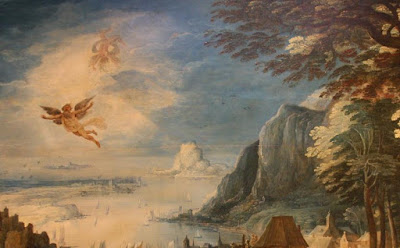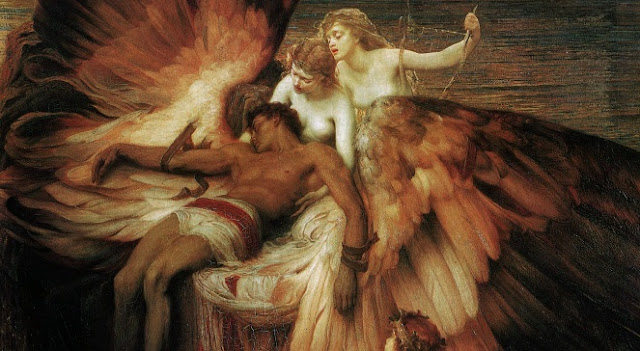Daedalus was a craftsman and artist in Greek mythology, who had two sons, Icarus and Iapyx. He is best known as the creator of the Labyrinth, a huge maze located under the court of King Minos of Crete, where the Minotaur, a half-man half-bull creature dwelt. According to the myth, the king of Athens was forced to pay tribute to King Minos by sending seven young men and seven young women each year to Crete, in order to be sacrificed to the Minotaur. One year, however, the legendary hero Theseus was sent into the labyrinth and managed to kill the Minotaur, assisted by Minos' daughter, Ariadne.
Later, Daedalus was kept imprisoned in a tower in Crete, so that the secret of the Labyrinth would not be spread to the public. In order to escape, Daedalus created two sets of wings for himself and his young son Icarus, by using feathers and glueing them together with wax. He gave one of the sets to Icarus and taught him how to fly. However, he warned him not to fly too high as the sun would melt the wax, nor too low as the sea water would soak the feathers. They left the tower jumping off the window and started flying towards freedom. Unfortunately, Icarus, forgetting his father's advice, started flying higher and higher, thus causing the wax on his wings to melt; he fell into the sea and drowned, while a nearby island took the name Icaria after him.
Daedalus eventually reached the island of Sicily, where he was welcomed at the court of King Cocalus. There, he built a temple in the name of Apollo and offered his wings to the god. In the meantime, Minos had started a search for Daedalus. Going from place to place, he asked if anyone could solve the riddle of running a string through a spiral seashell. When he went to Sicily, Cocalus knew that Daedalus would be able to solve the riddle and asked him to do so. Daedalus took an ant and attached the string to it, and then lured it into the seashell with a drop of honey. Thus, Minos found out that Daedalus was hiding in Cocalus' court, and demanded that he be sent to him. Cocalus told Minos he could first relax and take a bath; when Minos went into the bath, Cocalus' daughters killed him.
Later, Daedalus was kept imprisoned in a tower in Crete, so that the secret of the Labyrinth would not be spread to the public. In order to escape, Daedalus created two sets of wings for himself and his young son Icarus, by using feathers and glueing them together with wax. He gave one of the sets to Icarus and taught him how to fly. However, he warned him not to fly too high as the sun would melt the wax, nor too low as the sea water would soak the feathers. They left the tower jumping off the window and started flying towards freedom. Unfortunately, Icarus, forgetting his father's advice, started flying higher and higher, thus causing the wax on his wings to melt; he fell into the sea and drowned, while a nearby island took the name Icaria after him.
Daedalus eventually reached the island of Sicily, where he was welcomed at the court of King Cocalus. There, he built a temple in the name of Apollo and offered his wings to the god. In the meantime, Minos had started a search for Daedalus. Going from place to place, he asked if anyone could solve the riddle of running a string through a spiral seashell. When he went to Sicily, Cocalus knew that Daedalus would be able to solve the riddle and asked him to do so. Daedalus took an ant and attached the string to it, and then lured it into the seashell with a drop of honey. Thus, Minos found out that Daedalus was hiding in Cocalus' court, and demanded that he be sent to him. Cocalus told Minos he could first relax and take a bath; when Minos went into the bath, Cocalus' daughters killed him.


Comments
Post a Comment